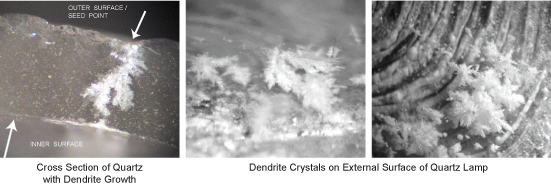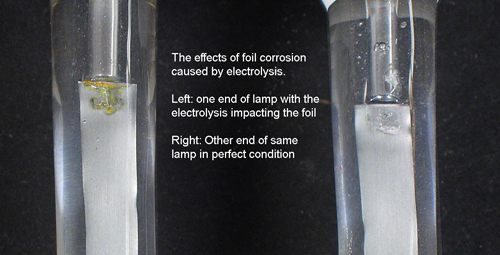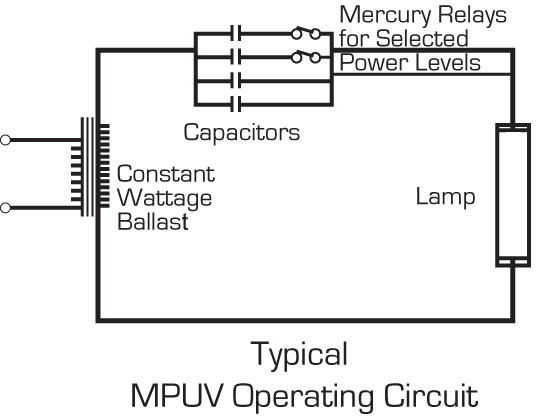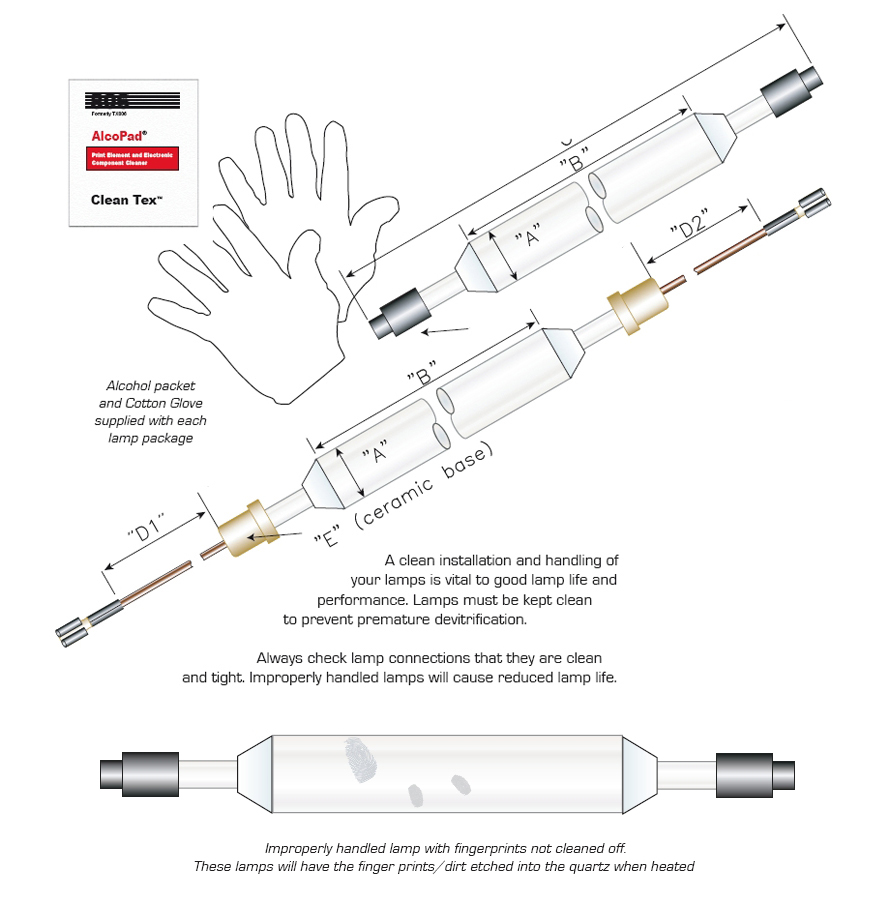What causes some quartz HID lamps to become curved (“bow”) during use?
The simple answer is: “they got too hot”, but, there are supple details to consider. Most of these are outside of the control of the lamp manufacturer. The equipment designer must address these problems.
For example:
At full power operation the temperature of the quartz wall of the main body should be between 800°C and 1000°C. The ends of the lamp should be no greater than 350°C. The reason for the lower temperature of the lamp ends is to keep the electric leads from oxidizing and failing. The metal inside the quartz is molybdenum which, if too hot, will expand enough to shatter the ends and/or start to oxidize and no longer conduct electricity. This leads to arcing and lamp failure.
The reason for the higher temperature on the body is to keep it below the strain point of fused silica. The strain point of a glass is a temperature below which you will not cause permanent strain to build into the glass. The strain point of fused silica is roughly 1070°C. Keep the body at 1000°C or below and you should be fine.
The problem comes in when the lamp is put in a fixture where it must be cooled. These fixtures are designed to focus the energy to a work surface, but, also trap the heat near the lamp. How much extra heat can a quartz lamp take? That is the problem. For long lamps it is a very important problem.
Glasses have a characteristic temperature called the annealing point. At this temperature the glass is still too “rigid” to deform, but, the molecules have enough energy to move slightly. This is enough to allow built up strain to relax and is also a point where you can force strain into the glass. Unfortunately, the annealing point for fused silica is roughly 1140°C, only around 60°C above its strain point. Not a lot of difference and easy to build up in an enclosed fixture.
What next?
Well, in addition to temperature we also must consider the WEIGHT of the lamp. The HID lamps are basically rods only held by the ends. The longer the lamp the more mass it has. When you hold it by the ends, all that mass puts the force in the center of the rod. Short HID lamps rarely bow during use even at high temperatures as there is so little force pulling is down. Longer lamps are easy to bow if too hot. (To illustrate this point, go to a home improvement store. Find metal rods. Find a short one and hold it up on each end. It will probably look straight. Try again with a much longer piece. Bet ya it sags in the middle!)
The next defining characteristic of any glass is a value called the glass transition temperature. Once you hit this point the glass lose its “rigidity” and can become more “plastic”. Get the glass to this temperature, add some force (like its own weight) and it is possible to deform (bow) it. Unfortunately, the glass transition temperature of fused silica is only around 1200°C. Again, not much higher than its annealing point of 1140°C.
So, if you have a long HID lamp, which weighs a lot, and it gets too hot by just a little, it will bow. Not only will it bow, but since the pressure inside a full power lamp is usually greater than the air pressure, the lamp gets bigger in diameter. It blows up like a balloon.
Why don’t the lamps just go “bang”?
Well, very luckily it’s a slow process. If the lamp is overheated by the reflector it will bow and get slightly bigger in diameter. As it bows it moves away from the accumulated heat of the reflector. So it will get cooler. Also, as it gets bigger in diameter its power goes down which also makes it cooler. Once the lamp cools to below its strain point, everything stops and the lamp is happy. Bowed, but stable and happy.
So, if your lamps bow you may have to redesign the enclosure or decide on reducing the lamp power. It’s just too much heat.
Avoid Dendrite Growth
Below are photos one of one the these growths. The quartz just happens to break along the crystal. All dendrites are formed as the result of an external influence. In HID lamps dendrite is something that gets onto the outside of the lamp that reacts with the hot quartz. As a direct result, the lamp envelope is weakened. The quartz slowly converts from a glass to a crystal. Once the crystal grows completely through the glass there is an open tunnel for air to enter the lamp. Eventually, the lamp ceases to function.

Electrolysis
Metal halide lamps employ the same starting-probe resistor connection as mercury lamps and as a direct result they also suffer from electrolysis. In fact, they suffer much worse from electrolytic seal destruction because they all contain alkaline iodides. These iodides can condense in the area behind the cathode and produce an ample supply of alkali ions to enter the silica in the vicinity of electrode molybdenum foil. This large concentration of alkali, then, is readily caused to migrate toward the probe foil by negative potentials on the foil, with the result that seal failure occurs within a few hundred hours.”
Electronic Discharge Lamps by John F. Waymouth, The M.I.T. Press, Cambridge Massachusetts, and London England.


How Does UV Curing Work?
Exposure to UVA (medium pressure UV curing) or UVC (low pressure UV curing) create a chemical reaction to cure a variety of inks, adhesives, and finishes. Our low pressure and medium pressure UV curing bulbs as well as amalgam lamps are used in a variety of industrial applications and are being used to change from heat-cured inks to the safer alternative of UV-cured inks.
How is UV Light Used in Curing Adhesives?
There are two components in a UV-curing adhesive: the resin and a photoinitiator. When the UV light with the correct intensity is absorbed by the photoinitiator, a chemical reaction occurs that produces a byproduct that hardens the resin.
Keeping a Clean Environment
Medium-pressure mercury arc lamps do not normally fail abruptly. Degradation in lamp output take place slowly until insufficient UV light is emitted for the lamp to cure effectively. This decline is the deterioration of UV transmission of the quartz jacket.
A number of factors contribute to the speed of this decline, including:
- Contamination of the lamp’s external surface (dust etc.),
- Lamp cooling
- Power rating
- Current rating of the electrodes
- Electrode cooling efficiency
- Switching frequency
Lamp Cooling
Proper cooling is essential for efficient UV curing and proper lamp life. Improperly cooled lamps are the major cause of premature failure and unnecessary lamp changes.
Overcooling on a lamp running in idle mode: often the power is turned down on a lamp when it is not being used to conserve energy. If the lamp is cooled too much at this lower power, the mercury will condense. This causes the lamp voltage to drop drastically and the lamp gets “caught in the glow mode.” (See further details in trouble shooting)
Equipment when put into an idle mode must still have enough power to start the lamp. The cooling must be appropriately reduced so that the lamp does not get over cooled and go into a low power mode causing the lamp to burn itself out.
Under cooled lamps causes the quartz tube to overheat and distort as well as the electrodes to sputter off all of their metal on to the interior of the quartz tubing- turning the end dark silver/black.
Lamps when not cooled properly can quickly reached temperatures in excess of 1200 degrees F.
Properly cooled lamps should not be distorted and usually have gradual blackened ends as the electrode sputters over its life.
MPUV Lamp Operation
MPUV lamps will operate properly only if the auxiliary equipment conforms to the physical, electrical and thermal specifications established by Voltarc. The recommended temperature range is 600°C to 750°C maximum. Higher temperatures will cause devitrification and distortion of the quartz envelope resulting in short lamp life, while lower temperatures will inhibit proper mercury vapor pressure resulting in decreased output.
MPUV Maintenance Tips
There are three common ways in which a lamp will prematurely fail:
- Trying to start the lamp at too low a power:
When a lamp is cold and started it does not have very much power. What little power there is heats the mercury. The lamp power increases as the mercury goes from a liquid to a gas. Lamp cooling is often designed for the lamp at full power. When the power is too low the lamp cooling can prevent the mercury from vaporizing. The lamp remains in a low power state and never gets hot. We call this continuous low power arc being “caught in a glow mode.” The lamp is not hot enough to start since it is being over cooled causing the electrodes to sputter their tungsten off to the quartz. The lamp has burned itself out. - Too much cooling on a lamp running in idle mode:
Often the power is turned down on a lamp when not in use to conserve energy. Again, if the cooling to the lamp is too great at this lower power the mercury can condense. The lamp voltage drops drastically when the mercury condenses. Again, the lamp is “caught in the glow mode.” When the equipment is put into an idle mode there still must be enough power to the lamp and the cooling must be appropriately reduces so that the lamps do not get over cooled and go into a low power mode causing the lamp to burn itself out. - Never going to complete arc when starting:
Sometimes a ballast will not supply enough current immediately on starting to even get the electrodes warm. The lamp may flash on, but, the arc is very small, narrow and looks like a snake twisting and turning. We call this a “snaking lamp” and it is the worst case. Although you see an arc it is only about 0.010Amp in current. The electrodes never get very warm. The ballast does not react with more power. The electrodes destroy themselves within minutes. This is a special problem on low voltage and/or short arc length lamps. If the ballast does not have enough starting voltage and short circuit current, it will not react to the small current flowing through it. This is the reason we like to have the starting voltage value of a ballast. We can test lamps under those conditions before they leave our plant. Lamps when caught in a low power arc can burn themselves out within a matter of minutes
Tips for Extending Lamp Life
- Avoid excessive cold starts.
- Start lamps at high power.
- Avoid excessive lamp starts.
- Cleanliness of lamps and equipment; especially the ventilating system is critical.
- Check and replace reflectors regularly.
- Clean installation of your lamps is vital to good lamp life.
- Lamp connections must be clean and tight.
Trouble Shooting – Check Chart for MPUV Lamps & Systems
| Symptom | Possible Cause | Corrective Action |
| Lamp will not start | End of Life | Replace lamp |
| Poor Socket Contact | Check lamp for tightness in the socket | |
| Low supply voltage | Check if primary input is <10% of rated primary voltage of ballast. If so, correct regulation | |
| Low socket voltage | Check ballast tap and connections | |
| Failed ballast | Replace ballast | |
| Abnormally low ambient temperature | Use ballast rated for low temperature operation | |
| Lamp has abnormally short life – Over wattage/excessive lamp current loading (may be evidenced by burnt seals, melted connector, bulged arc tube or discolored bulb). | Use of failed or improper ballast | Replace ballast or lamp to make them compatible |
| Ballast wrong for supply voltage and frequency | Used ballast compatible with supply voltage and frequency | |
| Shorted capacitors (for constant wattage and constant watt auto-transformer circuits) | Replace capacitors | |
| Lamp flickering or cycling on and off | Failing ballast | Replace ballast and use compatible ballast |
| Low ballast | Open circuit volts | Replace ballast and use compatible ballast |
| Supply voltage dips – Do not allow supply voltage to dip below -10% of rated primary volts of the ballast | Poor electrical connection | Check contacts and wiring |
| Insufficient open circuit voltage, hard starter | Check supply voltage, starter | Replace lamp |
| End of life depreciated lamp | Replace lamp | |
| Wrong lamp for ballast | Use matching ballast | |
| Incorrect tap or low supply voltage | Correct tap-connection, regulate supply voltage per ballast requirements | |
| Dirty lamp or fixture | Clean lamp and fixture routinely | |
| Early blackening/bulging of arc tube, caused by over wattage, incorrect ballast, etc. | Match tap connection to line voltage, use matched lamp and ballast | |
| Failed capacitor | Replace capacitor |
Typical MPUV Operating Circuit
MPUV lamps are used in various other photochemical processes and require ballasts specifically matched to the operating characteristics of the lamp. Ballast may be designed to perform at varying power levels. A typical schematic diagram of a MPUV lamp circuit:
 [
[
What are the safety issues for MPUV lamps?
- Mercury vapor lamps emit UV rays, which are harmful to human tissues!
- Avoid looking at lamps when they are operating!
- Reflected UV radiation is also very harmful.
- Ozone is harmful to human tissues.
- Ozone-producing lamps should only be used in properly-ventilated areas.
What Are the Types of UV Adhesives?
There are a wide variety of UV-curing materials, but there are two main types generally used in production assembly: epoxy based and acrylic based.
- Epoxy adhesives use a catalytic cure mechanism. The catalyst is a byproduct from the reaction of the photoinitiator to UV light. Areas of the adhesive not directly exposed to UV light can still cure.
- Acrylic adhesives cure by free radicals produced when the photoinitiator is exposed to UV light. All areas of the acrylic adhesives must be exposed to the UV light.
What does UV mean for MPUV lamps?
Ultraviolet light (UV) is invisible electromagnetic radiation with a wavelength shorter than that of visible light, but longer than x-rays, in the wavelength range of 10 nanometers (nm) to 400nm. A nanometer is about 1/100,000 the thickness of a human hair. UV light is found in sunlight, and is also emitted by electric arcs. It is useful as a tool: it can be employed for actinic purposes such as producing chemical reactions. One particularly important industrial application is the curing or drying of chemical compounds, inks and coatings. In recent years, it has seen increasing use in the inactivation of microorganisms (bacteria).
This post is also available in:
 Chinese (Simplified)
Chinese (Simplified)




